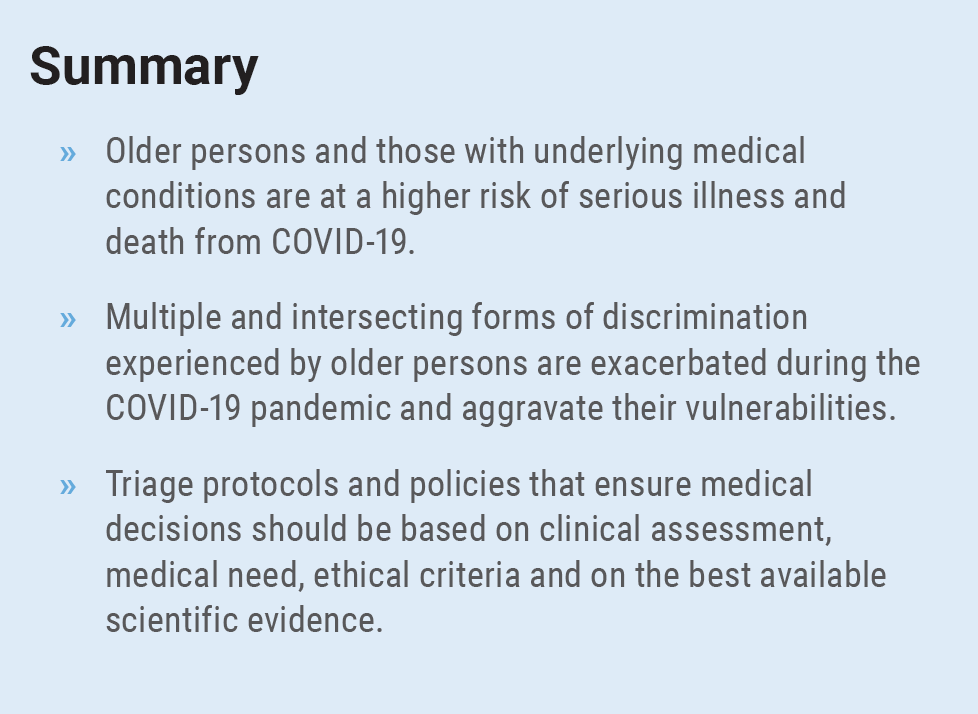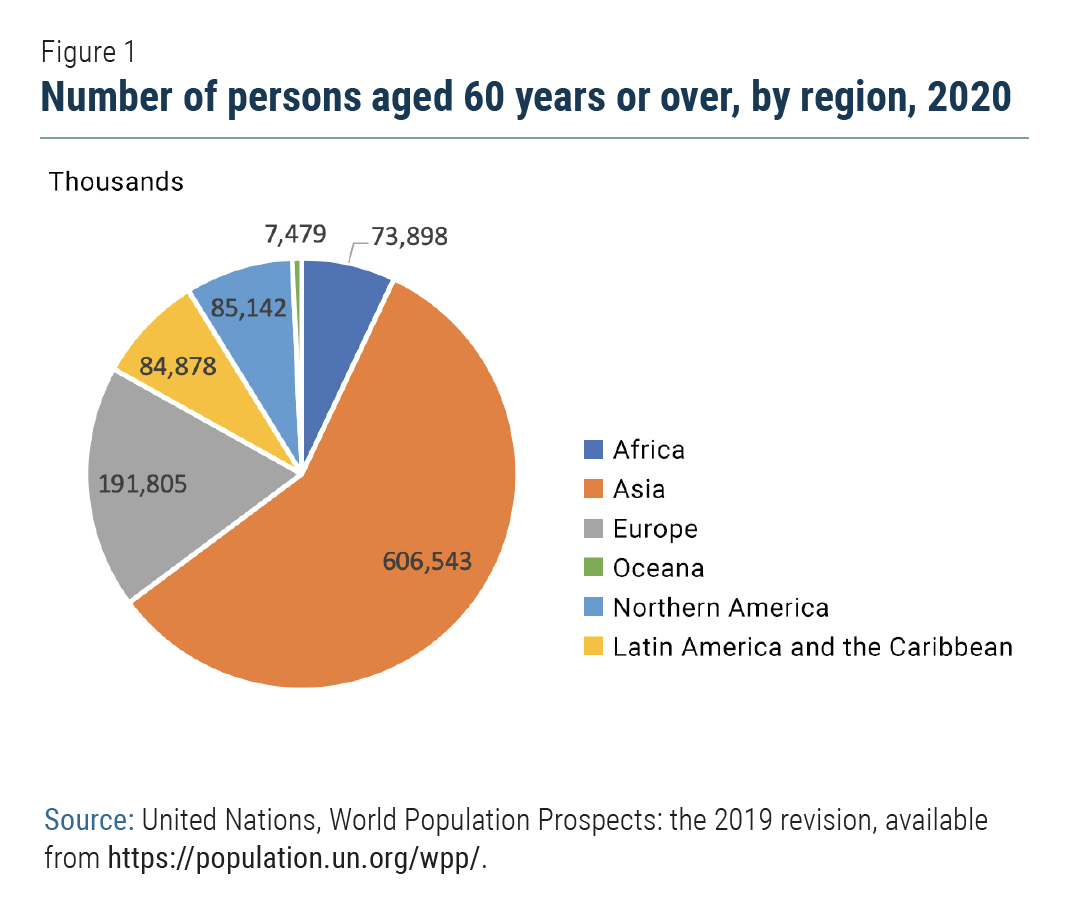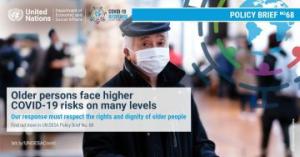 As the world grapples with an unparalleled health crisis, older persons have become one of its more visible victims. The pandemic spreads among persons of all ages and conditions, yet available evidence indicates that older persons and those with underlying medical conditions are at a higher risk of serious illness and death from the COVID-19 disease.
As the world grapples with an unparalleled health crisis, older persons have become one of its more visible victims. The pandemic spreads among persons of all ages and conditions, yet available evidence indicates that older persons and those with underlying medical conditions are at a higher risk of serious illness and death from the COVID-19 disease.
Often, chronic health conditions are more prevalent in old age; increasing risks for older adults. The World Health Organization has reported that over 95 per cent of fatalities due to COVID-19 in Europe have been persons aged 60 years or older. Several sources suggest that as data from fatalities in nursing homes become available, the death toll among older persons in the European region might be higher especially since often official data on fatalities do not include people who die in their homes or in care homes. Indeed, international evidence, although still limited, shows that people living in nursing homes are experiencing high rates of mortality due to COVID-19.
This reality highlights the specific challenges and needs faced by older persons in this health crisis and the need to plan and implement a response that is informed, inclusive and targeted. Meanwhile, retired doctors and nurses, despite their higher risks as older persons, have been fighting on the front line to temporarily support the overwhelmed medical system, in response to calls by several governments. Unfortunately, an alarming phenomenon has likewise surfaced in recent weeks: the pervasive effect of widespread age-based discrimination against older persons, with outcomes ranging from increased isolation to violations to their right to health and life on an equal basis with others. A successful response to COVID-19 must recognize and equally address such concerns.
Public discourses that focus on fatalities more than on infections portray COVID-19 as a disease of older people, leading to social stigma, discrimination and exacerbating negative stereotypes about older persons.
Societies should address existing deep-seated inequalities and age discrimination and advocate for older persons’ autonomy, independence and a stronger protection of access to social services, including social protection, and their human rights. Governments need to ensure that older persons are consulted and participate in policy decisions that affect their lives and must put in place supportive measures that guarantee their inclusion.
Ensuring equal access to healthcare
In the context of COVID-19, available evidence points to challenges in access to healthcare by older persons and to the negative impacts that measures to limit the spread of COVID-19 can have among this age group, especially in relation to their access to social services, including social protection. The Madrid International Plan of Action on Ageing identifies barriers to healthcare services and recognizes that older persons can experience age-based discrimination in the provision of services when their treatment is perceived to have less value than the treatment of younger persons. International human rights law guarantees everyone the right to the highest attainable standard of health and obligates governments to take steps to provide medical care to those who need it, including mental health support. Yet, in the midst of the crisis, concerns have been raised on decisions made around the use of scarce medical resources, including ventilators, based on age. For instance, in the United Kingdom, the National Institute for Health and Care Excellence uses age (65) to decide if a patient should be assessed through a frailty scoring system instead of through an individualized assessment, even though it recognizes the limitations of this scale as the sole assessment of frailty.
 Governments should develop and follow triage protocols and policies that ensure medical decisions are based on clinical assessment, medical need, ethical criteria and on the best available scientific evidence, while respecting the will and preference of the person. Decisions on access to screening and care should not be based on non-medical characteristics, including chronologic age, or discriminatory beliefs of social worth whereby older persons’ lives may be deemed less valuable than others. Consent for all aspects of medical treatment, including refusal and withdrawal, need to be free, prior and informed and guarantee that older persons make these decisions without undue influence or under pressure. Where older persons require representatives, these should be freely chosen by the older person and a model of supported decision-making should be put in place to ensure that the patient is empowered to make choices. Older persons should also be provided with adequate palliative care, if appropriate.
Governments should develop and follow triage protocols and policies that ensure medical decisions are based on clinical assessment, medical need, ethical criteria and on the best available scientific evidence, while respecting the will and preference of the person. Decisions on access to screening and care should not be based on non-medical characteristics, including chronologic age, or discriminatory beliefs of social worth whereby older persons’ lives may be deemed less valuable than others. Consent for all aspects of medical treatment, including refusal and withdrawal, need to be free, prior and informed and guarantee that older persons make these decisions without undue influence or under pressure. Where older persons require representatives, these should be freely chosen by the older person and a model of supported decision-making should be put in place to ensure that the patient is empowered to make choices. Older persons should also be provided with adequate palliative care, if appropriate.
Where older persons experience multiple and intersecting forms of discrimination, these are exacerbated during the COVID-19 pandemic and aggravate the vulnerabilities of older people. Older women provide the bulk of care in their households, and their ability to continue doing so without endangering their own health is contingent on their access to adequate healthcare. Persons with disabilities, 46 per cent of which are aged 60 and over, generally have more healthcare needs, including underlying conditions that make them more vulnerable to severe symptoms from COVID-19. As a result, challenges in access to healthcare and other services impact them more than the general population.
The pandemic has revealed how pre-existing health inequalities play a role in COVID-19 outcomes. For instance, initial data from the United States, suggest that African American populations, irrespective of age, might be disproportionately affected by COVID-19. Older persons that live in low and middle-income countries, especially those in conflict and crises settings face increased risks due to poor access to healthcare, other social services, and the absence of any meaningful social protection floors.
In its response to the pandemic, health systems and other social services systems should be responsive to the specific needs of different population groups and address the impact of socioeconomic and other inequalities on health outcomes.
Strengthening social support while implementing physical distance
An increasing number of countries are implementing restrictions in the movement of persons to halt the spread of the COVID-19 disease. Whereas such actions are likely to prove crucial, they need to incorporate the different conditions and realities of older persons so as not to increase their social isolation and worsen their wellbeing and health outcomes.
Older persons increasingly reside alone. Available data show that older persons have become more likely to live independently, with co-residence with children becoming less common. While living arrangements differ substantially across countries and regions, considerable changes have taken place in several world regions. In more developed regions living only with a spouse is the most common living arrangement among older persons, followed by living alone. Large gender gaps in the proportion of older persons residing alone exist, with more older women residing alone than older men. Where physical distancing is not implemented with supports in place, it can lead to increased social isolation and denial of support to older persons at a time when they may be at most need of care and support.
Where older persons live together with other family members, implementing adequate physical distance within households is crucial to prevent the spread of COVID-19 to older adults, as long as such measures are in full consultation with older persons and on a voluntary basis. Data available in European countries on the share of people aged 30–49 who live with their parents, show that fatality rates due to COVID-19 are initially higher in countries with more intergenerational interactions. Living with at least one child or with extended family members is the most common living arrangement among older persons in less developed regions. Skipped generation households are common in sub-Saharan Africa, Latin America and the Caribbean countries. In such settings, implementing in-house physical distancing may be particularly challenging. The transmission risk might be even higher if older persons live with younger children that are asymptomatic and therefore carry the potential to spread the virus unknowingly.
Older persons living in long-term care facilities have a higher risk for infection and adverse outcomes from the disease because they live in close proximity to others. As a result, many facilities have taken measures such as restricting visitors and group activities, which can negatively affect the physical and mental health and well-being of residents. Older people, especially in isolation and those with cognitive decline, dementia, and those who are highly care-dependent, may become more anxious, angry, and withdrawn during the outbreak or while in isolation. Visitor policies should balance the protection of older residents with their need for family and connection. While the risk to older people is serious, blanket policies on visitors, access to legal aid, and advocacy services do not take into account public health guidance or the needs of older people. Policies should ensure that older persons residing in long-term facilities have equal access to healthcare in all countries, especially as initial reports point to the neglect of many people living in such facilities emerge.
Similarly, places of detention such as prisons, jails and immigration detention centers, where the virus can spread rapidly, pose higher risks to their older population, especially if access to healthcare is already poor. Governments should ensure medical care for those in their custody equivalent to that available to the general population, and must not deny detainees, especially those more at risk such as older persons, equal access to health care and other services.
Many older people rely on uninterrupted home and community services and support. Ensuring continuity of these services and operations means that public agencies, community organizations, healthcare providers and other essential service providers are able to continue performing essential functions to meet the needs of older people.
Older persons face barriers to community engagement, whereby they may not be able to gain access to information about protecting themselves and accessing relevant services, which can aggravate exclusion or marginalization experienced by some older persons. Such barriers include language barriers or lack of access to technologies.
The role of the internet and other digital technologies as a window to the world and the channel to connect with family, friends and the community has been amplified by measures related to COVID-19. Yet, many older persons have limited access to technology. For instance, one-third of adults 65 or older in the United States declare never using the internet. Data in in the United Kingdom indicate that more than half of the adults who have never used internet in the country are aged 75 years and over, with a higher proportion of older men using internet with respect to women. This digital gap can also affect the ability of older persons to make use of services such as telemedicine or online shopping, which could prove crucial where physical distancing restrictions are implemented. In low-income and other developing countries, technological challenges for older persons are exacerbated.
Where physical distance policies do not consider the specific challenges and conditions faced by older persons, food insecurity, becomes a key concern, especially for older persons who are quarantined, isolated and without safety nets and with limited funds.
 Welcome to the United Nations
Welcome to the United Nations
